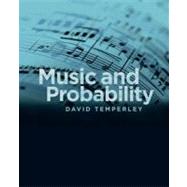
Note: Supplemental materials are not guaranteed with Rental or Used book purchases.
Purchase Benefits
What is included with this book?
| Preface | p. ix |
| Introduction | p. 1 |
| Probabilistic Foundations and Background | p. 7 |
| Elementary Probability | p. 7 |
| Conditional Probability and BayesÆ Rule | p. 8 |
| Other Probabilistic Concepts | p. 14 |
| Early Work on Music and Probability | p. 19 |
| Melody I: The Rhythm Model | p. 23 |
| Rhythm and Meter | p. 23 |
| Previous Models of Meter Perception | p. 26 |
| A Probabilistic Rhythm Model | p. 30 |
| The Generative Process | p. 31 |
| The Meter-Finding Process | p. 36 |
| Testing the Model on Meter-Finding | p. 41 |
| Problems and Possible Improvements | p. 43 |
| Melody II: The Pitch Model | p. 49 |
| Previous Models of Key-Finding | p. 50 |
| The Pitch Model | p. 56 |
| Testing the Model on Key-Finding | p. 62 |
| Melody III: Expectation and Error Detection | p. 65 |
| Calculating the Probability of a Melodic Surface | p. 65 |
| Pitch Expectation | p. 66 |
| Rhythmic Expectation | p. 71 |
| Error Detection | p. 74 |
| Further Issues | p. 76 |
| A Polyphonic Key-Finding Model | p. 79 |
| A Pitch-Class-Set Approach to Key-Finding | p. 79 |
| The Generative Process | p. 83 |
| The Key-Finding Process | p. 85 |
| Comparing Distributional Models of Key-Finding | p. 89 |
| Further Issues in Key-Finding | p. 92 |
| Applications of the Polyphonic Key-Finding Model | p. 99 |
| Key Relations | p. 99 |
| Tonalness | p. 108 |
| Tonal Ambiguity and Clarity | p. 116 |
| Another Look at Major and Minor | p. 121 |
| Ambiguous Pitch-Collections in Common-Practice Music | p. 125 |
| Explaining Common Strategies of Tonal Harmony | p. 131 |
| Bayesian Models of Other Aspects of Music | p. 139 |
| Probabilistic Transcription Models | p. 139 |
| Bod: The Perception of Phrase Structure | p. 143 |
| Raphael and Stoddard: Harmonic Analysis | p. 147 |
| Mavromatis: Modeling Greek Chant Improvisation | p. 151 |
| Saffran et al.: Statistical Learning of Melodic Patterns | p. 156 |
| Style and Composition | p. 159 |
| Some Simple Cross-Entropy Experiments | p. 161 |
| Modeling Stylistic Differences | p. 166 |
| Testing Schenkerian Theory | p. 172 |
| Communicative Pressure | p. 181 |
| Communicative Pressure in Rules of Voice-Leading | p. 182 |
| The Syncopation-Rubato Trade-Off | p. 184 |
| Other Examples of Communicative Pressure in Rhythm | p. 191 |
| öTrading Relationshipsö | p. 197 |
| Low-Probability Events in Constrained Contexts | p. 202 |
| Conclusions | p. 205 |
| Notes | p. 209 |
| References | p. 225 |
| Author Index | p. 237 |
| Subject Index | p. 241 |
| Table of Contents provided by Publisher. All Rights Reserved. |
The New copy of this book will include any supplemental materials advertised. Please check the title of the book to determine if it should include any access cards, study guides, lab manuals, CDs, etc.
The Used, Rental and eBook copies of this book are not guaranteed to include any supplemental materials. Typically, only the book itself is included. This is true even if the title states it includes any access cards, study guides, lab manuals, CDs, etc.